Heather is a seasoned
Pinterest marketing expert & educator using the platform since you could reach the bottom of the feed - 2010.
About Heather Farris >
How to Create a Pinterest Conversion Campaign (Step by Step Tutorial)
June 11, 2024
Are you looking to run Pinterest ad campaigns, specifically a Pinterest conversion campaign, and wondering how to get started? Are you looking for transparent marketing strategies, optimization best practices, and a tutorial on how to set it up? Well, today’s post will walk you through all that.
Before you create a Pinterest conversion campaign
We’re going to just jump right into the tutorial. After the tutorial, we’ll talk about strategy and optimization notes that you should be aware of with your Pinterest conversion campaigns.
A little bit of couple of housekeeping items before we get started. Make sure you:
- Upload your pin images to your Pinterest account already fully optimized for your ad campaigns before you start.
- I would also encourage you to do the keyword research you want to add to the campaign before you start.
That way, as soon as you start the campaign and start creating it, you can pop those things in, and you’re not waiting on any other elements. You can just create the campaign and publish it.
RELATED: How to Use Keywords to Optimize Your Pins on Pinterest
Install your conversion tag
Let’s assume we already have all of that done. I’m also assuming that you have installed your conversion tag if you’re running a conversion campaign and already have events firing on that campaign.
To find that out, in your Pinterest Business Hub, you will go to Conversions (essentially the ads manager). Inside the Conversions screen is where your tag lives. You’ll also see any events that have fired off in the last 3, 7, 14, and 30-day periods.
RELATED: How to Use Google Tag Manager to Install Your Pinterest Tag
How to create a Pinterest conversion campaign
- Go to ‘Create Campaign’ in your Business Hub menu.
- Select ‘Manual campaign’ as your creation method.
- For the campaign objective, choose ‘Conversions’. These are for driving people to take a specific action with our promoted pins, not just a consideration campaign.
Set your campaign name
I like to do whatever digital offer I’m promoting for as the name of my campaigns. You can do something completely different if you want to. Let’s say this is a Pinterest conversion campaign for my Strategy Guide and I’m wanting to use Video Ads. So I named mine “Strategy Guide | Video Ads.”
Set your budget for this campaign as a daily budget
I suggest not starting with anything less than $20 per day for conversion campaigns. Otherwise, you risk not getting the conversions as quickly as you want. The algorithm may take longer to optimize, and you may lose more money than you want.
So I would suggest a minimum of $20 a day for content creators like myself promoting e-mail list opt-ins, digital product sellers, or if you’re an e-commerce seller and promoting physical products.
If you ARE e-commerce promoting physical products, I would look at your cost of goods sold and potentially budget higher for that. For example, if your product is $50 and it takes you $15 to get a purchase, then you know that $20 a day should be about good.
All campaigns on Pinterest now are campaign budget optimized. So you have to put your budget in on the campaign screen. Leave it as ‘Daily’ and ‘Run Continuously’. Click ‘Continue.’
RELATED: How to Master Pinterest Ads for Digital Products – Step by Step Guide
Ad Group details
I like to name my ad group based on the targeting that I am using. So for this example, I’ll name it “Keywords + Interests + Expanded Targeting”.
Next, in your Targeting Strategy, you have three options.
- Reconnected with users: for those wanting to do a retargeting campaign.
- Find new customers: ideal if you want to go broader and get new people into your campaign.
- Choose your own.
I always choose my own. I never select the other two. However, if you’re new to Pinterest ads and you have no experience here, you may select one of those. But I’m going to walk you through the full gamut of what I do.
My targeting details setup
Skip past the ‘Audience lists”. The Pinterest conversion campaign setup is a cold campaign, so we are creating a cold conversion campaign looking for new people we’re prospecting.
We’re going to come into our ‘Interests and keywords’, and we are going to look at the Interests first. If you are confused about what interests you should choose, I suggest going to your ‘Audience Insights’. Click on your menu button to find it.
RELATED: 12 Pinterest Audiences to Use to Make More Money on Your Ads
Choosing interests and keywords
Inside your Audience Insights, select ‘Your total audience’. In the list down below, it will show you the highest affinity categories that your audience gravitates toward. They may be categories and interests that are similar, or very different to your products and services. But if they’re similar, these are the interests we’re looking to add into your Pinterest conversion campaign.
For example, for me, many people in my audience are interested in finance, and many business interests map over to the finance side of things. If I were a finance blogger or finance creator, I would choose all of the interests. However, for those of us who don’t have as many interests that map over, you may choose the lower level interests that narrow down further.
Back over in my campaign interests, I could come in here and choose Finance for this campaign. If you select a top level interest, it will include all of the more specific sub-interests below. Be sure you click into the lower interests so you don’t bulk select something irrelevant.
For my audience, I would search for things like small businesses or internet marketing to see if there’s anything else that would come up. So search for all relevant interests and filter from there.
Add keywords to help guide the Pinterest conversion campaign
From here, click over to ‘Add keywords’. I have a regular list of keywords I’ve already been using on Pinterest. For you, just paste in your keywords in the box. I wouldn’t suggest adding a ton of keywords to the campaign.
Keywords guide your campaign overall and help the algorithm understand who is searching for your product on top of their interests. That doesn’t mean that keywords are not going to serve, because they will. However, interests will almost always suck up all the budget from the targeting. So just keep that in mind.
It says the best practice is to use a minimum of 25. I would start with that. Add any keywords that are related or relevant to your campaign. They don’t just have to be about the topic at hand. For example, I use Pinterest Marketing often.
I could also do keywords for Tailwind, social media marketing, Instagram, and Facebook because I know my audience is also interested in those other things. They may be searching for those other things, not knowing they need what I am giving them or what I’m presenting to them in the ad.
You can add things that are not directly on topic but very relevant, but you don’t want to go too far off-topic.
RELATED: How to Use Keywords to Optimize Your Pins on Pinterest
Leave your demographics wide open
I always suggest leaving your demographics wide open. That means wide open to all genders, all ages, all locations, all languages, and all devices. Leaving it on ‘All’, especially if you’re just targeting the United States, will help Pinterest find your audience.
Use your demographics as an optimization method in campaign weeks two to four and beyond. You don’t want to start by narrowing your Pinterest conversion campaign down too much because then Pinterest will be strangled, and they will not know who to serve. So always start broad.
I leave these always open, with one exception: I always remove men. After lots of trial and error, I just don’t want to serve men in my business. I don’t have any interest in helping men in general. No offense if you’re a man watching this. I’ve had a lot of bad luck working with men over the years. All my ads with male demographics cost me a lot more money with greater frustration, so I always toggle them off. I usually advise my clients to do the same because, in many cases, my clients are women serving women.
Other Pinterest conversion campaign targeting details
Placement and Tracking: I always leave placement alone, and I don’t put any tracking URL’s in this section. I wait to put tracking URL’s on the individual pins if I’m going to do tracking.
Budget and Schedule: Your budget is set at the campaign level, so there’s nothing you can do here.
Optimization and Delivery: Your conversion tag will automatically be selected, and this is where you need to choose your conversion event.
Since we’re driving for new audience sign-ups, I would leave this defaulted to ‘Leads’ because they’re not in our funnel system yet. But you have four options to know about for later.
- Sign up
- Checkout
- Add to cart
- Lead
Bidding: Leave the bidding on ‘Automatic’. Pinterest is smart when it comes to optimizing your campaigns based on bids at the auction if it’s automatic.
If you set a custom bid, you get to set an average target cost per day, and then you get to set a conversion window. I would not do this if you’re brand new.
Add pins to promote
Next step is it’s time to select your pins. The best practice here is to upload those pins before you even start creating a campaign. Always upload your pins organically to Pinterest first. That way, you can double dip in the organic and paid sides of things.
If you only upload them first as promoted, then you are required to let the ad run before anyone else can see it organically. If you upload it organically, people can see it, and it will live on your profile forever, gathering traffic juice.
That impact helps both your organic and paid reach instead of only being promoted first. So I just prefer to upload them organically and add them to the campaign in the last step. Make sure you fully optimize the pin title, pin description, and landing pages before you upload that pin to your campaign.
RELATED: How To Optimize Your Pinterest Ads
Finding old pins to promote
Now, if you don’t know what pin you want to use, and it’s not a recent one you’ve uploaded, you can find popular pins on your profile to use by grabbing their pin ID. Let me show you how that works.
In a separate window, go to your saved pins on your profile, find a popular pin you want to use. Then grab the number right in the URL bar, copy it, and put that back over to your campaign screen to search for it where you choose your pins.
It will take a minute to populate, but it will find your pin ID. There it is. You can always Click to see if you can make any quick edits.
Once you’ve chosen your pin, all you have to do is hit the ‘Publish’ button, and the ad will go into automatic review. It will go live really quickly and start spending.
That’s how you set up a conversion campaign.
RELATED: Pinterest Ads vs Facebook Ads: Which ad platforms should I use?
Conversion ads strategy and optimization notes
Now I want to talk to you about my most commonly used Pinterest Conversion campaign setup strategies.
One campaign: one ad group
I usually do one campaign with one ad group, because Pinterest ads are campaign budget optimization. Clients often come to me with their Pinterest ads they’re already running and they are not set up in a Pinterest-friendly way. They’re setting up ads that are more Facebook strategy than Pinterest Strategy.
With conversion budget optimization, your budget will be spread across the winning ads and the winning ads sets or ad groups. However, if you are testing and have a bigger budget, like a minimum of $40 a day, you can do one campaign with two ad groups. Then decide from the ad group level what you want to test.
So if you want to test keywords versus interests, then everything in the campaign, including the images, would be the same. However, if you wanted to test imagery and video against each other (standard static pins versus video ads), you could do one campaign, two ad groups. With that, have all your static images in one ad group and all of your videos in the other ad group.
Everything else would remain the same across both ad groups.
Duplicating ad groups
In that case of testing keywords above, I would create one campaign with one ad group, and then duplicate the ad group. That way, you set your one ad group up with all the targeting, and everything is the same. You don’t have to toggle back and forth between windows, and then you can add whatever the different keywords was of the first ad group.
You can do this in so many different ways. I wouldn’t suggest having too many ad groups in your campaign if you don’t have a big enough budget. You’re not going to know very quickly with a small budget and many groups which one will work the best. With one campaign, and one ad group, you can test multiple campaigns, targeting strategies, and interests. Just make sure they don’t overlap with each other and begin to compete. That’s the only thing to note.
RELATED: Pinterest Ads For Beginners Q&A
Things to not do with your Pinterest conversion campaigns
You should be aware of a couple of optimization things when running conversion campaigns. Baseline, you shouldn’t touch the campaign in the first seven days at a minimum.
Don’t wait too long to swap out imagery
If your imagery has not reached 0.55% on your click-through rate within the first seven days, you can go ahead and upload new images.
I would start with three images, or video pins, you can upload up to five in total. If you start with three, that gives you two more to upload within that seven-day time frame to see if Pinterest will like those better.
Then at week two, remove any underperforming images based on that click-through rate of .55. The click-through rate has to be .55 on conversion campaigns or higher to deliver in the algorithm and beat out your competition at auction. So aim for 1% but know that you need to beat that .55%.
RELATED: How to Create Pins for Pinterest in Canva: A Pinterest Image Workflow to Save Time
Don’t change your budget by more than 25 to 30%
Don’t change your budget more than 25 to 30% every three to four days up or down. This will force your campaign back into learning and could reset everything about your campaign that was working at the time.
So don’t scale your budget from 75% to 100%. Don’t go doubling and tripling it. And then, when that freaks out the campaign, drop it back down again. So stick to 25% to 30% and gradually scale up on this platform.
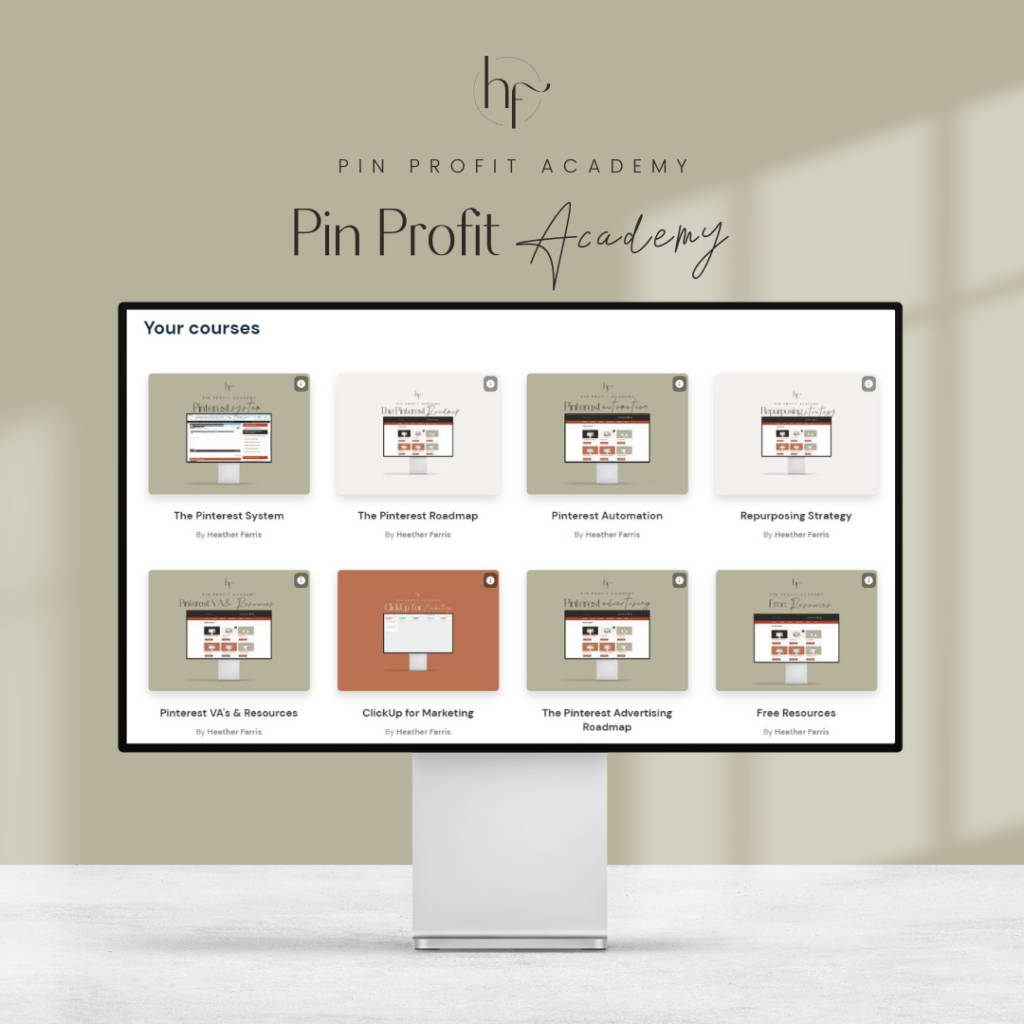
Pin Profit Academy
Marketing can be difficult and trying to figure it out on your own, especially with Pinterest, can be overwhelming.
I will show you how to double your traffic and sales without spending another minute on social media!
PPA is the only comprehensive membership program & community for creating, marketing & selling your products & services using Pinterest.
Don’t change placements often
Don’t change your placements too often because this can force your campaign back into learning and confuse the overall algorithm. We hardly ever change placements with our agency clients. Usually, we’re changing placements only because the campaign is on its last leg, and we are doing everything at that point for CPR to get it to perform again.
There is something that you should know about conversion campaigns in regards to placement. When you are filtering down by where your campaign is serving, when you’re in the ad group level and go to that little targeting drop-down at the top right of your table, you can choose the audience.
If you notice in your campaign, when you filter by interest, the majority of your budget is being spent on automatic, that is the “Browse” placement. That’s the home thread for most people who saw that ad. If you notice your campaign is just spending everything on automatic, make sure you don’t go and turn off “Browse” because that will also tank that performance for automatic.
Campaign fatigue is real
Campaign fatigue is a real issue you may have to deal with. We have one client in our agency roster whose campaign will fatigue about once a month, but this campaign has been running for almost a year.
Once a month or maybe twice a month, we update her imagery. We got the campaign completely optimized down to a point where we get excellent results for the goals we have set out. But her audience is quite small.
So keep an eye on your frequency levels inside your ads reporting dashboard. If you notice your frequency is getting above two or three, then you know that your audience is really small. This means Pinterest is burning through it fast and showing your ads a lot. So you need to ensure you’re staying up to date on your images to keep the campaign performing at its best.
So if you get to a point where:
- You’ve optimized your campaign completely
- There’s nothing more that you want to remove, nothing more you want to add
- You are capping out on your frequency
- Your campaign performance has gone down week over week, month over month
- Your goal, be it check-out or sign-ups, is going downhill
Then change your imagery and make sure to stay on top of that.
RELATED: How to Recycle Your Pinterest Pins Without Looking Spammy
When to start optimizing your Pinterest conversion campaigns
The last thing I will note is optimization. As a rule of thumb, do not optimize your Pinterest conversion campaign for targeting until at least 14 days. Ideally, you’ll wait 21 days to start doing this because Pinterest takes much longer to optimize your ads as a platform. The longer the ads have been running, the better they usually perform if you have a dialed-in product or a dialed-in audience that you know is converting.
Removing underperforming
I don’t usually start optimizing anything with our agency clients until about day 21, but I would say the minimum is 14. That’s when you can begin peeling out any demographics that are:
- underperforming on click-through rate,
- too high on CPM,
- or too high on what else you care about as far as metrics.
Often we will remove any underperforming interests. So the cost per action is too high; even though we’re getting checkouts and we can get checkouts lower cost per action on a different interest in the campaign. We will remove the underperforming ones.
So if you’re not getting any Add to carts after 14 days on your interests, that could be a good indicator that you need to remove that interest and allow the campaign to spend elsewhere.
When to archive campaigns
The last little thing you will want to do in your optimizations is archive campaigns after 14 to 30 days. This is a big window of time. We don’t archive keywords a ton in our agency client campaigns. It’s a one-off thing we will do occasionally, maybe monthly. We will remove keywords that are just underperforming.
If you have hundreds of keywords in your campaign, none of them are spending, and none of them are getting anything on them, you can archive those campaign keywords and let the campaign try to push that budget elsewhere.
If you notice that the campaign is spending one cent, two cents, up to like $0.10 on a keyword, but you’re not seeing anything on them, go ahead and get rid of them and allow that money to be spent elsewhere.
RELATED: How to Write Pin Titles on Pinterest That Make People Want to Click: + Pin Title Template to Swipe!
Final thoughts on how to create a Pinterest conversion campaign
Creating Pinterest conversion campaigns can be a big learning curve, but this step-by-step guide hopefully has been helpful. Be sure to checkout the Promoted Pins playlist on my YouTube channel for more training videos here. Everything you need to know about adding campaigns to your Pinterest marketing strategy is there.
Or reach out for a consultation if you’d like to look at my agency helping handle your ad campaigns for you. You can book a call with me here, your go-to Pinterest strategist to see if it would be a good fit for you.
Pin it for later
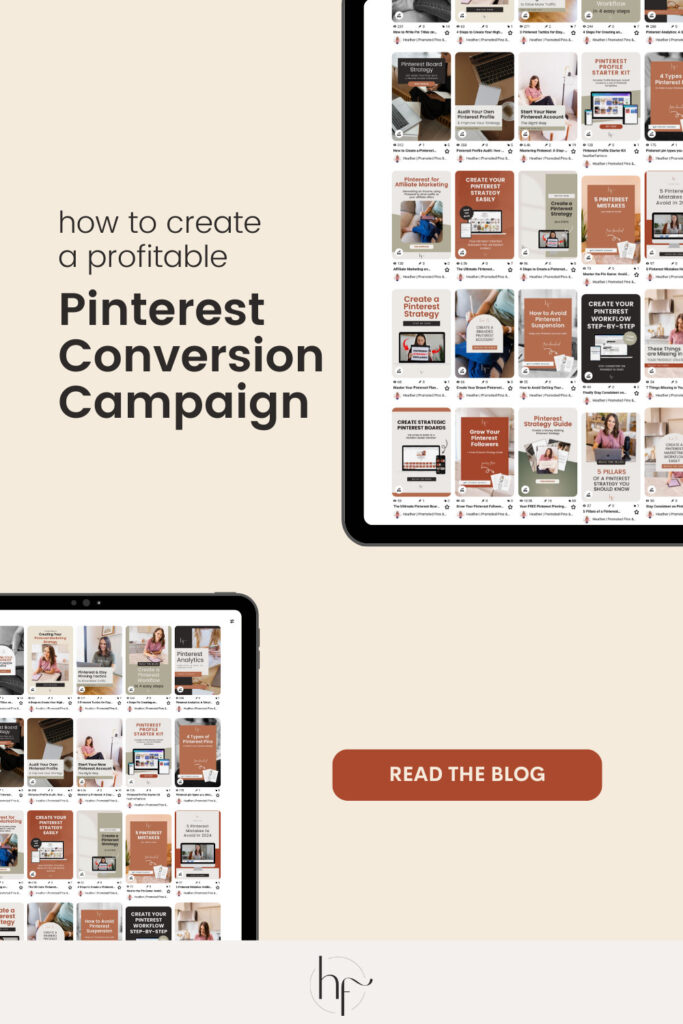
Heather Farris went to school for accounting and worked for years in banking and finance. After finding all of that entirely too boring she started her first blog in her basement in August of 2016. She has started 3 blogs in the marketing, motherhood and travel niches and used Pinterest to grow them all. She quickly became the go-to Pinterest strategist in her peer circles and has been implementing strategies, driving traffic and sales through organic and paid tactics for her clients. On this blog and her YouTube channel, as a renowned Pinterest marketing expert, she educates the public about clear and transparent marketing strategies to help them to grow on Pinterest and in other places online as a renowned Pinterest marketing expert.
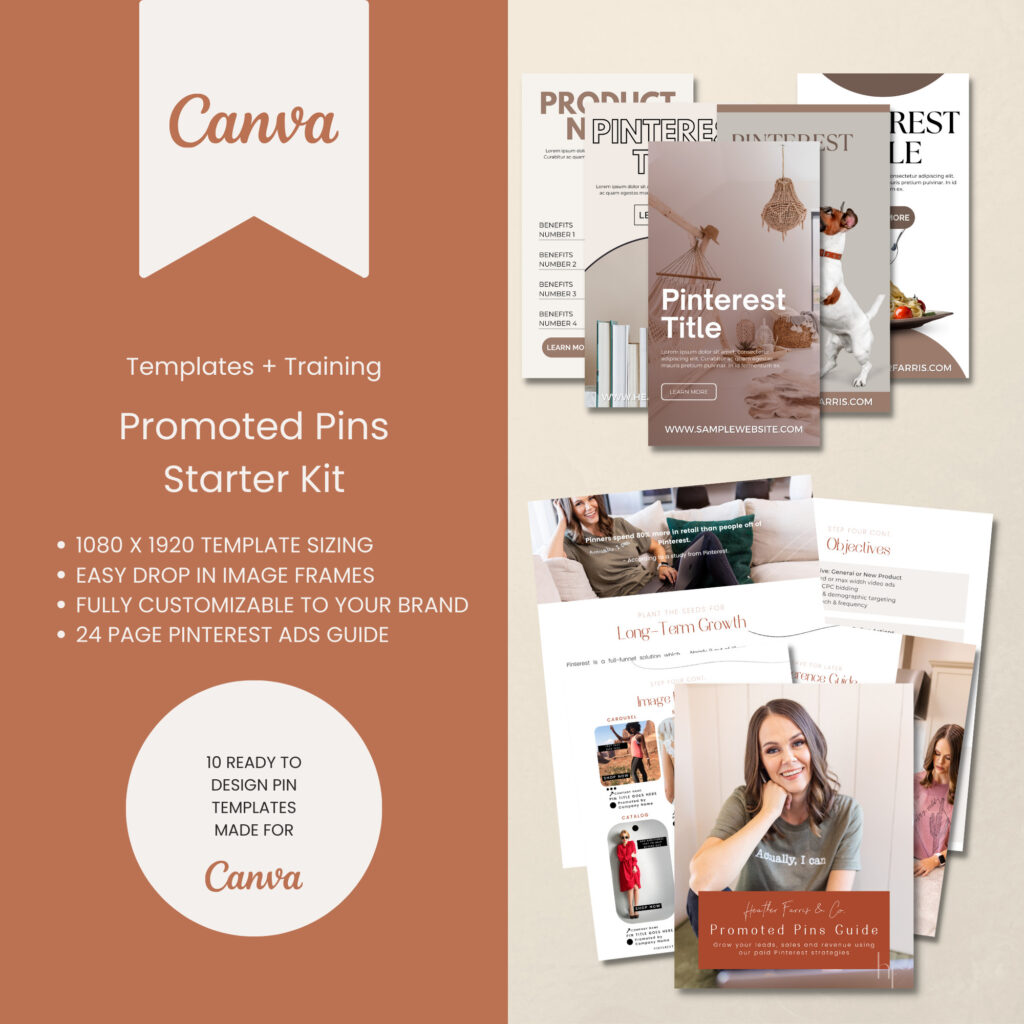
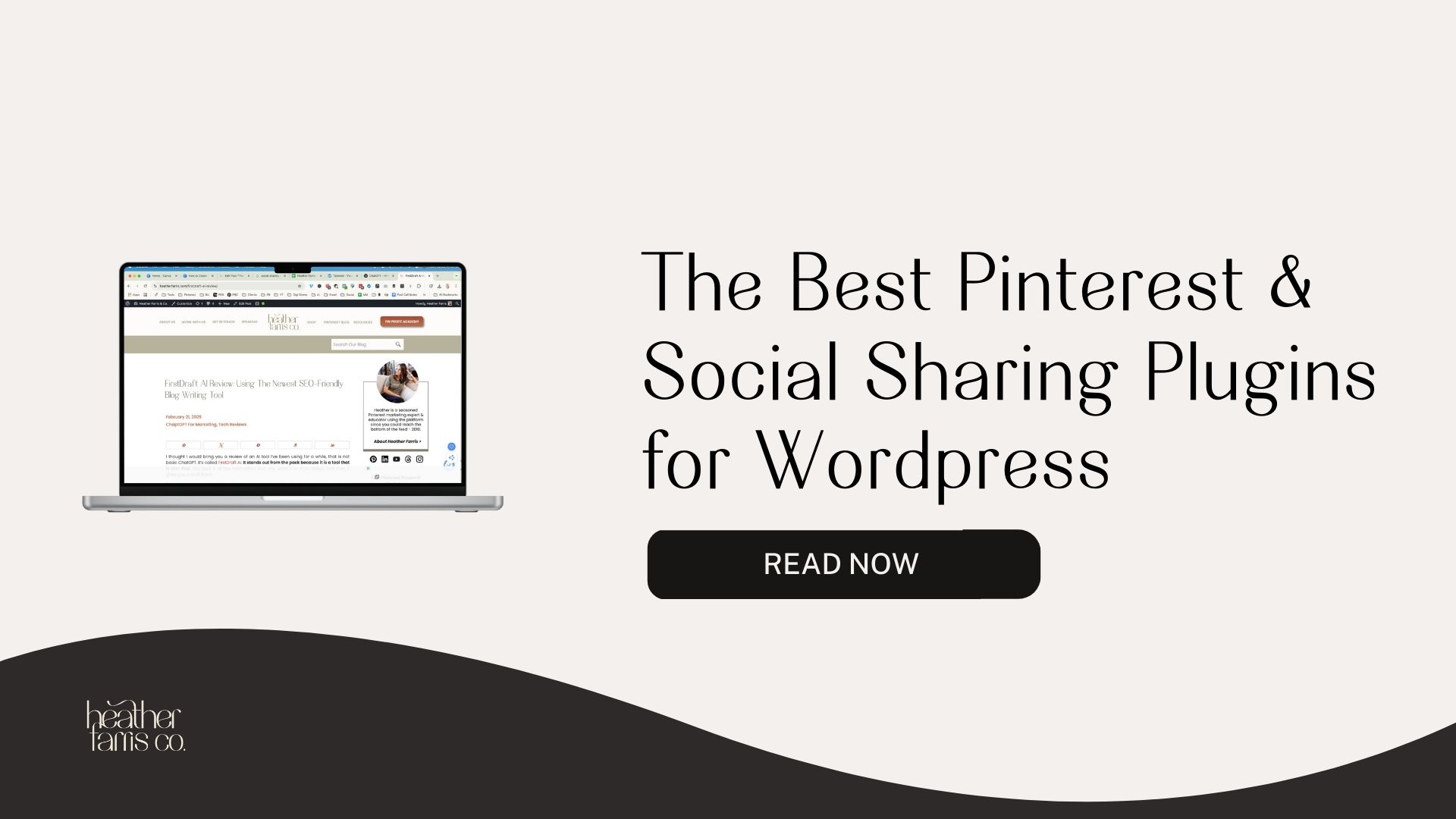

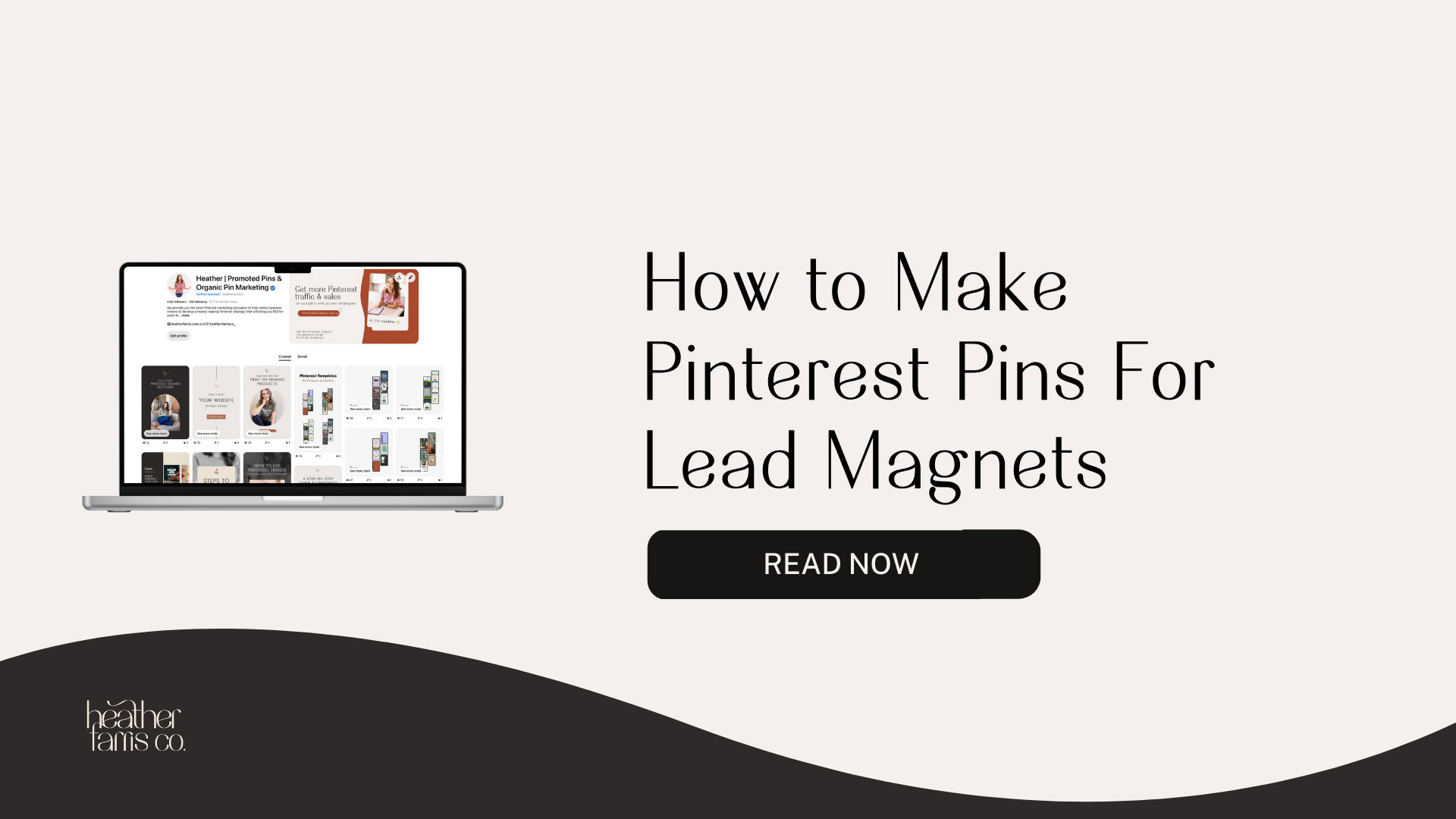
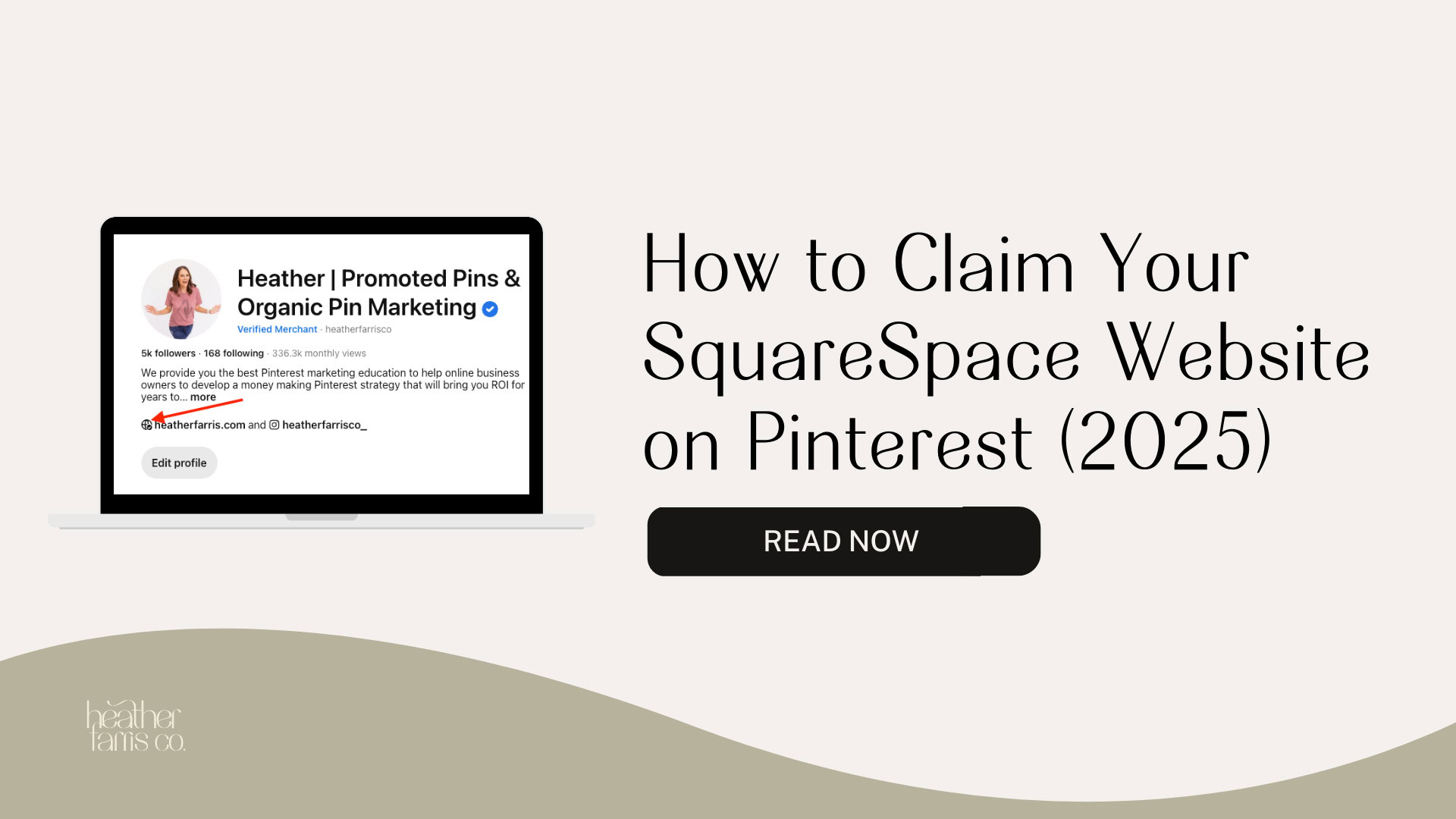
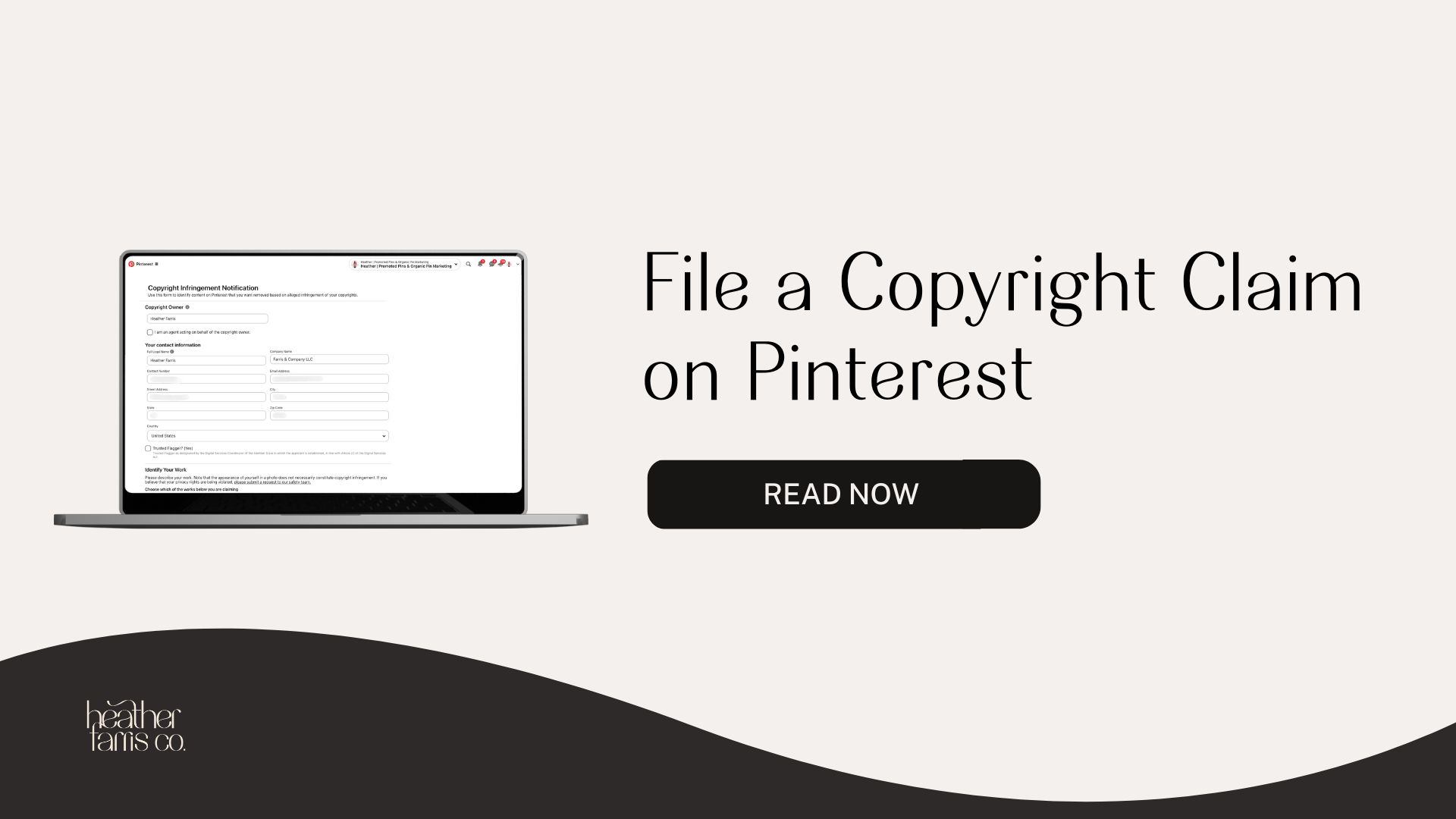

[…] RELATED: How to Create a Pinterest Conversion Campaign (Step by Step Tutorial) […]